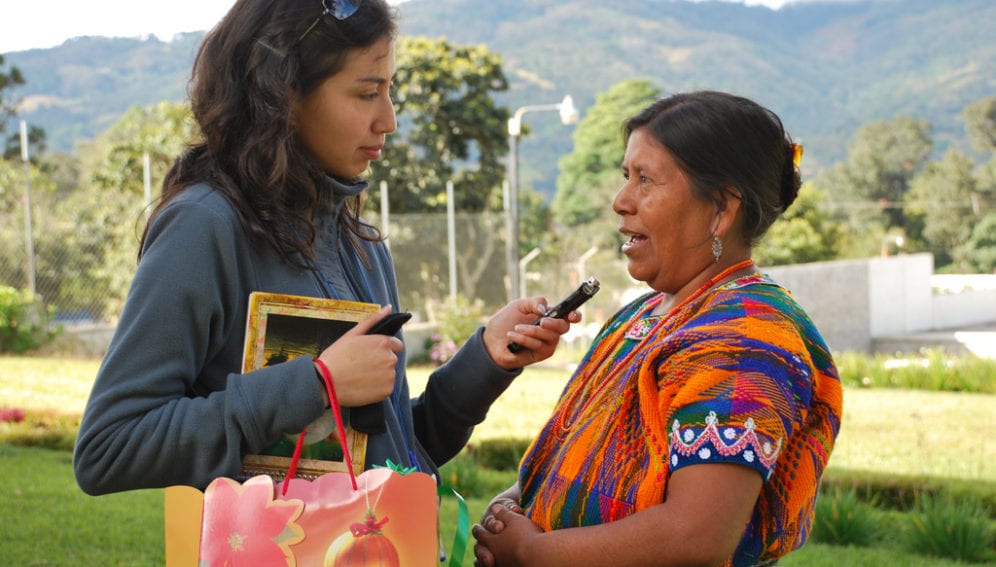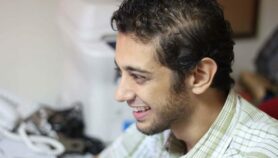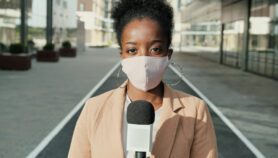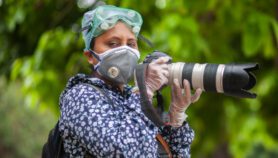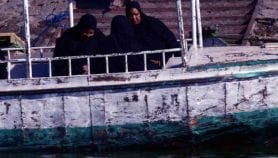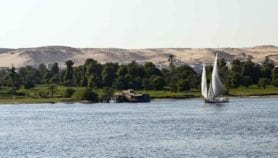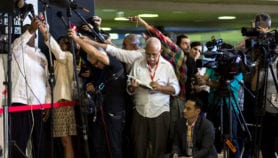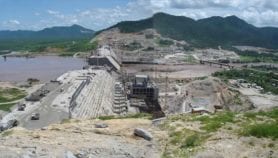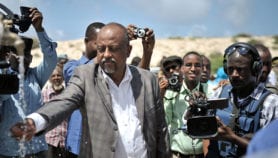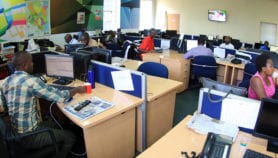By: Aleida Rueda and Cecilia Rosen
Send to a friend
The details you provide on this page will not be used to send unsolicited email, and will not be sold to a 3rd party. See privacy policy.
How is work to improve science coverage faring across the diverse region, ask Cecilia Rosen and Aleida Rueda.
[BUENOS AIRES/MEXICO CITY] A 2011 workshop in El Salvador on science journalism was an eye-opening experience for Will Monterroza, a Salvadoran journalist who helped organise the event as a part of a regional project to boost the number and quality of science stories in Latin America’s media.
“The experience was key for me not only because I learnt to do science journalism, but also because it allowed me to reflect on why it is important for the general public to get closer to scientific knowledge,” says Monterroza, who now works for a local radio station where science is one topic he covers.
The workshop was “extremely relevant” in El Salvador because there is no established route for science journalists’ professional development, he tells SciDev.Net.
With his new appreciation of the need to increase science’s presence in the media, he is seeking funding to make a television show for the university he studied in, Don Bosco University, featuring science news and interviews with scientists.
Monterroza is one of around 180 journalists in Latin America and the Caribbean who have participated in the Ibero American Network for Monitoring and Training in Science Journalism. This initiative is part of the growing interest for training and research initiatives that are starting to build capacity in science journalism, while addressing some of the challenges facing the profession in the region.
The need for training, regional networking and boosting the work of science journalists associations has been discussed at the recent 13th International Public Communication of Science and Technology Conference (PCST2014) held in Salvador, Brazil (5-8 May). Journalists and academics there called for more and better science to be represented in the media.
But how do you train journalists to report on science in a region as diverse as Latin America, where research giants such as Brazil have a scientific workforce of over 230,000 producing over 26,000 papers a year, yet tiny Nicaragua has only around 300 scientists and 50 publications a year, according to UNESCO data?
Training and monitoring network
Perhaps one of the most exemplary initiatives in this area is the Ibero-American Network for Monitoring and Training in Science Journalism.
The network, which was created in 2009, is composed of journalists and researchers from nine countries: Argentina, Bolivia, Brazil, Colombia, Ecuador, Mexico, Portugal, Spain and Venezuela. It aims to enhance the quality of science journalism in these countries in order to improve the links between science and society in the region.
Last June, it concluded training and evaluation activities, financed by the Ibero-American Programme for Science, Technology and Development, an intergovernmental initiative to promote research and innovation cooperation.
“Instead of criticising, it’s much more interesting to monitor coverage of science in order to obtain data useful for training. We must leave the critics behind and draw up a map of science journalism in the region.”
Luisa Massarani
In its first four years, the network has offered training workshops for journalists, journalism students and in some cases, scientists. These sessions have taken place in parts of countries with little or no science journalism capacity: Ecuador and Guatemala in 2009; Brazil, Colombia and Nicaragua in 2010; Bolivia, El Salvador and Venezuela in 2011; and Honduras in 2012.
In each case, the goal was to provide understanding and skills to journalists and others attending — an average of 80 in each workshop — so they could reflect on how to communicate science through the media.
“We realised that there were several groups — all very small and emergent, and with little support — which had the same desire to learn about monitoring and training in science journalism. And so we proposed the network as an opportunity to consolidate something that has already begun in several countries,” says Luisa Massarani, coordinator of the network, who is also the coordinator of SciDev.Net’s Latin America & Caribbean edition.
Impact in small countries
It is difficult to measure what concrete impacts the network’s workshops have had, mainly because the changes in how the media and journalists themselves see science journalism are only likely to be apparent in the long term. But there are examples showing how important the initiative has been, especially for individual journalists.
For small countries such as El Salvador, Guatemala and Nicaragua, which have few or no science journalists and limited training opportunities, these programmes have encouraged participants to pursue a career in science journalism.
In Nicaragua, the workshop exceeded organisers’ expectations and created debate. “As co-organisers, we were surprised with the excellent reception from students. They had a very active and demanding participation,” says Jorge Huete Pérez, president of the Nicaraguan Academy of Sciences.
Soon after the workshop, the country’s Central American University expressed an interest in organising further training events and creating a course on science communication.
In addition, the academy and the Nicaraguan Council for Science and Technology signed an agreement to promote science communication, and the Inter-American Development Bank also showed interest in financing activities such as science popularisation and training for science communicators. But the initiatives are all on hold due to a lack of money, according to Huete.
Funding has proved an obstacle for journalists and scientists who want to strengthen science communication in Nicaragua.
“Although the workshop generated interest among participants, the lack of funding for concrete activities threatens to postpone the development of the science communication area in the country,” Huete says.
In Guatemala, the university that hosted the workshop afterwards provided a course in science journalism. One of the participants also paid for another workshop, this time on how to report on biotechnology.
“Unfortunately, in the mass media there haven’t been big changes since then,” says Lucy Calderón, a science journalist who is the network’s local partner.
Although local journalists became interested in covering science, she says, newspapers lack science and technology sections. “They only publish small stories on new gadgets of the same brands that have adverts on those pages,” she says.
Tailored training
The network’s members have learned how local realities determine the precise challenges every country faces when trying to increase the media’s science coverage, they say. Science journalism in itself is diverse in the region, with some countries having more tradition in the field than others.
Understanding and taking into account the differences between countries has been crucial for the network, they say, and that is why each training session brings up discussions on content and methods relevant to that country.
“The workshops were always triggered by a person or a relatively small group of journalists or academics — usually local scientists and journalists — with specific needs and interests in science journalism,” says Javier Crúz, a Mexican science journalist and professor involved in the network.
This model is said to allow participants to share their views about and experiences of science journalism, thereby ensuring the workshop covers more than just the speaker’s views on how it should be practised.
“The profile always changed: in Bogota in Colombia, we had a packed audience of highly qualified professionals and so there were plenty of questions and discussions. In other places, the discussions were less sophisticated,” says Crúz.
He thinks these differences stem from the fact that working conditions of journalists — as well as the ways science is produced — vary across Latin America.
This could be related to disparities between each country’s science and technology systems. In a 2010 report on science, UNESCO (the UN Educational, Scientific and Cultural Organization) revealed that just four nations — Argentina, Brazil, Chile and Mexico — host 92 per cent of the 252,000 researchers in the region, while countries such as Cuba and Nicaragua have the highest rates of ‘brain drain’ (see this story, in Spanish).
Crúz thinks those places with small scientific communities and meagre scientific infrastructure often also have fewer chances to develop their science journalism capacities and coverage. However, this is not always the case.
A 2011 study led by science writer Carla Almeida, examined the science coverage of 12 major newspapers in nine Latin American countries. It found that, in 2007, Costa Rica’s main newspaper published more science stories than the other newspapers examined, including those from Argentina, Brazil and Mexico, despite the country having a smaller scientific community and less of a science journalism tradition than those nations.
This, perhaps, shows the importance of systematic research on how different countries cover science in the region, which is the network’s other main goal alongside training.
News analysis
“In general, there’s a lot of criticism of science journalism. We think that instead of criticising, it’s much more interesting to monitor coverage of science in order to obtain data useful for training. We must leave the critics behind and draw up a map of science journalism in the region,” says Massarani.
The network’s most important research output has been creating methodologies for analysing science news coverage, according to Massarani. These were designed to find out how the local media approach science and identify their weaknesses so solutions can be proposed.
So far, the network has used the protocol to evaluate television channels’ science content in different countries and the plan is to compare the results in the near future.
A 2012 study on Brazilian prime-time television news show Jornal Nacional, for example, found that it generally covered science in a positive way, with little mention of related controversies, risks or harm. The study, which Massarani co-wrote, also found that 7.3 per cent of the show’s news coverage was dedicated to science. [1]
There is a trend among Brazilians to show science’s benefits and promise, the researchers say, pointing to a “utilitarian approach to science”. They see knowledge as a solution to problems instead of as a process or vision on how the world is.
Will the media listen?
Training and discussions on science journalism have taken place in the region since the 1960s.
Shortly after the launch of its Latin American desk in 2003, for example, SciDev.Net started to organise workshops in science journalism for the region.
This highlighted to many journalists and scientists the importance of science journalism, and helped them reflect on ways to evaluate science communication.
Since then, other countries in the region, such as Argentina, have also increased their training opportunities, which has helped to generate wider networks of journalists and researchers interested in communicating science.
One example is an annual workshop on science journalism for Latin American journalists who cover issues such as science, environment, health and climate. The training has been run by the US-based Institute of the Americas since 2003. Although the one-week workshop takes place in California, it is taught in Spanish.
Over the past ten years, more than 400 journalists have attended these trainings, Lynne Walker, the institute’s vice-president, tells SciDev.Net.
The Ibero-American Network’s members are fully aware of the limitations of the short workshops they offer.
“You cannot completely change science journalism in so short a time, but our expectation is that training provokes people to reflect on their own work,” says Massarani. “If we get a journalist out of the mechanical mode of covering science, to start to think a bit more on science, that will improve the quality.”
According to the Venezuelan journalist Acianela Montes de Oca, who participated in the network’s work, training “is useful to make visible scientific work that is frequently unnoticed” and for journalists to notice science produced in their own countries and to strengthen the relationships between researchers and science communicators.
Crúz goes further by saying that the most ambitious goal of the network’s monitoring and training tasks is to influence the Latin America media. “The media themselves should be the most interested ones in thoroughly researching the quality of their coverage,” he says.
According to Crúz, part of the problem is that most of them do not care about evaluating themselves and without society’s calls for change scholars have to work as intermediaries by showing media how to improve the quality of the content they publish.
That’s what the network’s participants did: research the media’s science coverage in the region publishing eight papers in total so far.
But its impact is still uncertain. “It will depend whether the media take it as an affront or as an opportunity to work together,” says Crúz.
Luisa Massarani is coordinator of the Ibero-American Network for Monitoring and Training in Science Journalism and of SciDev.Net Latin America and the Caribbean edition.
References
[1] Marina Ramalho and others From the laboratory to prime time: science coverage in the main Brazilian TV newscast (Journal of Science Communication, 2012)


